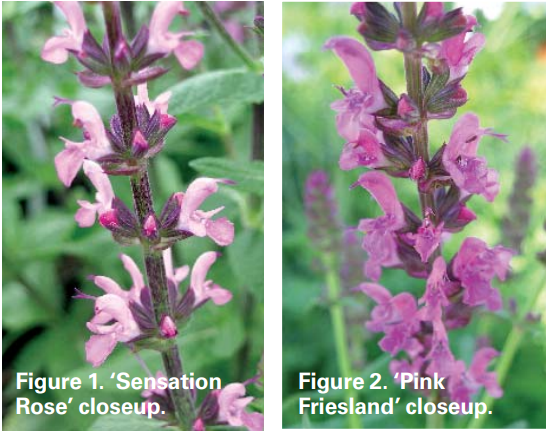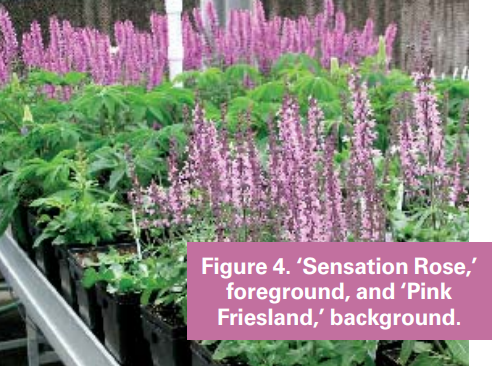
Production tips for top performers: Salvia sylvestris
DOWNLOADApril 29, 2008 - Cathy Whitman and Sonali Padhye
Production Tips For Top Performers Salvia sylvestris
Take a look at ‘Pink Friesland’ and ‘Sensation Rose,’ two cultivars of salvia. by CATHY WHITMAN and SONALI PADHYE.
People seem to either love it or hate it, but the color pink has undeniable appeal to many consumers and is a valuable element in the flower garden. Producers are probably familiar with the many varieties of purple-flowered perennial salvia available; they are widely grown and used in private homes and public landscapes. Two new introductions, ‘Pink Friesland’ and ‘Sensation Rose’, both offer attractive pink flowers. These patented cultivars are classified as Salvia sylvestris, which is synonymous with S. nemorosa, and are the result of breeding work in the Netherlands.
The flowers of ‘Sensation Rose’ are pastel pink with smooth, tidy foliage. The calyxes and stems are dark in color, creating an attractive contrast with the pastel flower petals (Figure 1). The petals of ‘Pink Friesland’ are a darker, more vibrant pink. The calyxes and stems of ‘Pink Friesland’ are also quite dark and make for a handsome inflorescence (Figure 2).

The genus salvia is a huge one, including over 700 species. Native salvias can be found in North, Central and South America, Asia and Southern Europe. Salvias have a long history of ornamental, culinary and medicinal uses. The genus includes annuals, tender perennials and hardy perennials; some are woody, some are herbaceous and many have aromatic foliage. They offer a wide palette of flower colors including white, pink, red, orange, purple, blue and even yellow. Flowers are tubular and often attractive to hummingbirds and butterflies.
A well-designed garden includes horizontal and vertical elements, in addition to various textures and a harmonious color scheme. Salvias are valued for the vertical shape of their flower spikes, which provide a lovely contrast to the many rounded, mound-shaped plants that fill our borders. They perform best in full sun and are drought tolerant once established. Salvia sylvestris is cold-hardy to Zone 4 and is a tough and adaptable choice for incorporating that vertical shape into borders and container gardens.
Forcing
Consumers are looking for color when they go plant shopping, so retailers want plants to be in bloom when marketed. We have worked with several perennial salvias and trialed these two new cultivars to see how their flowering requirements and general performance compare with that of older varieties.
Treatments
We started with 72-cell plugs of both cultivars. They had been exposed to cold temperatures before shipment and had minimal shoot growth upon arrival. Half of the plugs received a cold treatment of 10 weeks in a cooler set at 41˚F, lighted by fluorescent lamps for nine hours per day. Remaining plants received no cold treatment. All plants were forced in our research greenhouses at 68˚F, under one of three light treatments: nine-hour short days, 16-hour long days or 16-hour long days with supplemental light provided by high-pressure sodium lamps. Between the hours of 8 a.m. and 5 p.m., all plants received about 400 foot candles of supplemental light from high-pressure sodium lamps when the natural light intensity was below about 1,000 foot-candles.
Results
Both ‘Pink Friesland’ and ‘Sensation Rose’ were quick and easy to force. Like other perennial salvias we’ve worked with, cold is not needed for flowering, and they are facultative long-day plants. Flowering of long-day plants is promoted when the daylength or photoperiod exceeds a critical length. Facultative long-day plants like these salvias will eventually flower under short or long days, but bloom more quickly under long days.
Time to flower for ‘Pink Friesland’ forced under long days was four to five weeks; under short days, five to six weeks. Flowering time for ‘Sensation Rose’ was six weeks under long days and seven weeks under short days. Keep in mind that we use black cloth in our greenhouses to create short days that are only nine hours long, considerably shorter than photoperiods commonly encountered during commercial production.
Plant height of ‘Pink Friesland’ averaged 14 to 16 inches when the first flower opened while ‘Sensation Rose’ height was 13 to 15 inches. Both were 2 to 4 inches shorter when forced under nine-hour photoperiods (Figure 3).
The plugs used for this trial had already received some exposure to cold. The additional cold we provided resulted in slightly more uniform flowering, and less delay in flowering under short days, but had little effect on height or flower number. These results are consistent with those observed in other cultivars of perennial salvias we have worked with.
Other Cultivars
The flowering responses of ‘Pink Friesland’ were similar to those of ‘East Friesland,’ which we trialed in 2006. Our ‘Pink Friesland’ plants were 3 to 4 inches taller than the ‘East Friesland’ plants.
'Sensation Rose’ has been compared to ‘Marcus,’ which we trialed in 2004. In that trial, a 15-week cold treatment hastened flowering of ‘Marcus’ by two to three weeks. Our ‘Sensation Rose’ was 2 to 3 inches taller than ‘Marcus.’
Production Notes
Like most perennials we’ve trialed, these salvias grew well in our standard commercial peat-perlite medium. We provided constant feed with 125 ppm nitrogen from a complete fertilizer with micronutrients. Salvias are sun-loving plants and these cultivars were more robust with more branching and more flowers, under supplemental light.
Like other salvias, these cultivars are attractive to whiteflies, but we had no other insect or disease problems during production. Both are good choices to help keep your perennial sales “in the pink!” (Figure 4)



 Print
Print Email
Email

